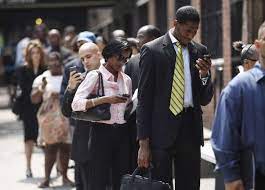Job growth in the US exceeded expectations last month, with employers adding 199,000 jobs in November, according to the Labor Department.

The surge was partly attributed to striking workers in Hollywood and the auto industry returning to work. This robust employment data pushed the jobless rate down to 3.7%, the lowest since July. The Federal Reserve, aiming to curb inflation, has raised interest rates to their highest level in over two decades.
However, the latest job gains and a 0.4% increase in average hourly pay from October may complicate expectations of declining interest rates.
Despite concerns that the Federal Reserve’s interest rate hikes could lead to an economic recession, the US economy has demonstrated strength, expanding at an annual rate of 5.2% in the most recent quarter. Consumer spending, a key driver, has been sustained by a strong labor market. However, some retailers have reported weakening sales recently. November’s job gains were led by the health care, manufacturing, and government sectors, while payrolls at retail, warehousing, and transportation firms fell.
Ian Shepherdson of Pantheon Macroeconomics suggested that the decline in retail payrolls could indicate nervousness among retailers or reflect adjustments for seasonal trends by the Labor Department. Despite concerns about slowing global growth, the US has averaged 240,000 job additions per month over the past year. While job growth has slowed compared to the previous year, it has held up well considering the challenging economic environment.
Richard Carter, head of fixed interest research at Quilter Cheviot, noted that while the full impact of rate hikes has yet to be felt, the current economic outlook appears strong in the US. Analysts are closely monitoring these economic indicators as the Federal Reserve navigates its efforts to control inflation and stabilize the economy.





